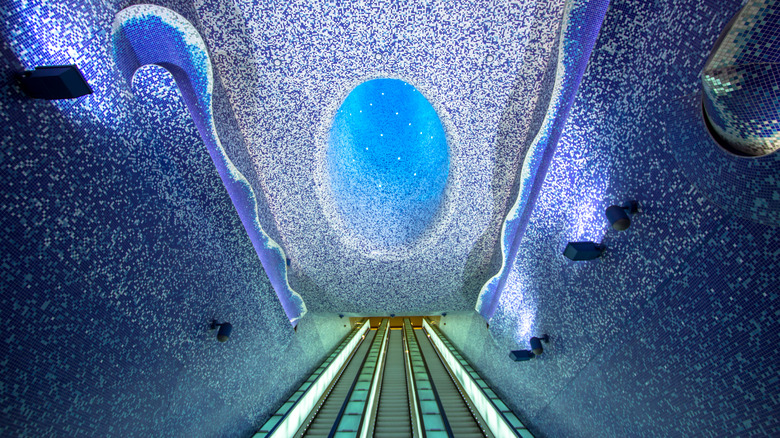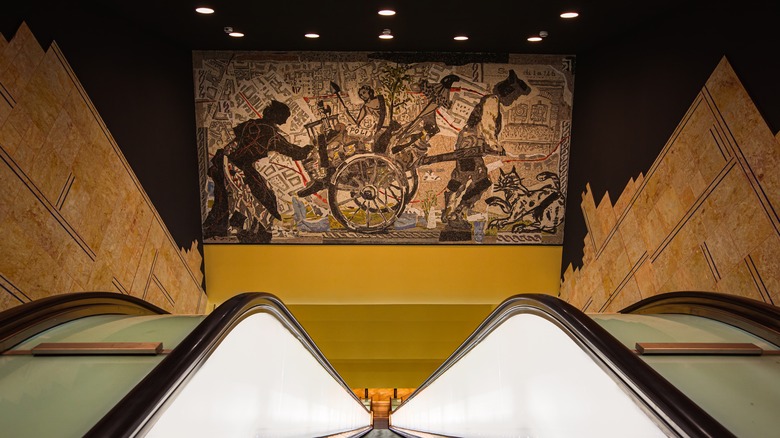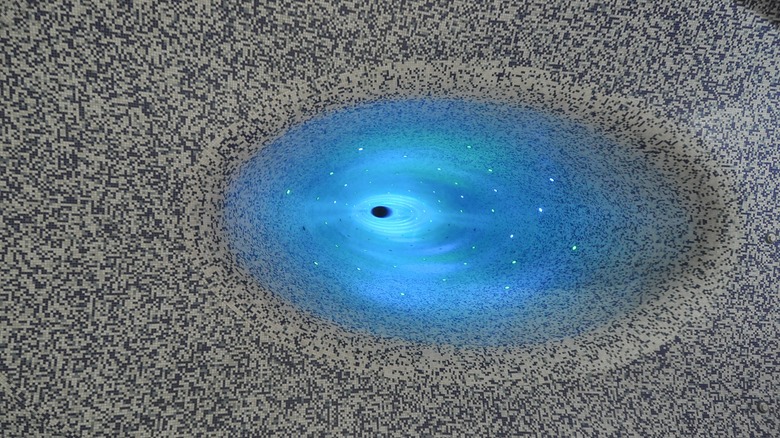This Attraction In Naples Is Considered One Of The Most Beautiful Transit Stations In Europe
You're deep under the sea on an alien planet, swimming through tunnels in an other-worldly reef as violet seas wink, shimmer, and ripple above you. But you're not really under an alien ocean at all — you're just 130 feet underground in Naples, Italy. To be exact, you're in the Toledo Station of the Metro Napoli transportation system, experiencing functional public art at its apex. This is widely considered one of the most beautiful transit stations in Europe, and it isn't difficult to understand why. It might even be a good enough reason all on its own to consider a visit to one of Italy's most underrated and misunderstood cities.
As you enter the station, you pass a trio of pyramids and a statue, then enter a powerful, deceptively formal, black-walled entry plaza that incorporates historic stone ruins and a classical mural. Then, you step onto the escalator and journey down through a transitional space before entering a fabulous undersea world. Everything appears pixelated, a little like a blue disco ball or a video game — the effect of hundreds of thousands of glass Bisazza tiles. Looking up as you float down the escalator, you gaze up a magnificent, brilliant blue tunnel of ever-wafting, twinkling light. The effect is undeniable.
The artist behind the Toledo Station
Located in the city's Spanish Quarter, Toledo station was appropriately created by Spanish architect, artist, and furniture designer Òscar Tusquets Blanca, who often styles himself with the mononym Tusquets. A dazzlingly creative force, Tusquets cites his countrymen Salvador Dalí and Antoni Gaudí as influences on his work. The biomorphic forms of the station's walls evoke Gaudí's nature-inspired architectural forms, which feel like they might have grown in place rather than being built mechanically. And Dalí's visual humor is also here, in that feeling that we are taking a magical ride through a topsy-turvy world of an artist's imagination. Tusquets — born in 1941 — counted Dalí as a friend, and the two even collaborated on witty, surrealist furniture, such as a chair wearing stiletto heels.
You can find other works by Tusquets (namely his whimsical chair designs) in the permanent collections of the Victoria & Albert Museum in London and New York's MOMA. You can even book a room at his soaring orange, white, and blue Princess Hotel in Barcelona, an architectural gem where a rooftop pool overlooks the Mediterranean Sea (just avoid the city's touristy La Rambla for dining). What could be better than art you can sit, ride or sleep in?
Art meets engineering in Toledo Station
This marvel of architecture, engineering, and creativity exists because of a decades-long effort Naples has made to beautify its metro stations. It takes a lot of engineering to make a piece of art look effortless. For example, that tunnel providing a view between the street and the escalator? The dramatic feature was an excavation for the construction of the metro that was always intended to be filled in until Tusquets came along and had a vision. A post-project cost-benefit analysis (available on Research Gate) showed that the architectural elements only amounted to 6% of the subway's cost but provided a great return in what the study termed "hedonic value" — shorthand for that soaring feeling your heart gets when you walk into the space. Turns out you really can buy happiness.
While the Toledo Station gets most of the accolades, other stations in the system are also worth a visit. Another beauty is the Università station, the work of internationally recognized art star Karim Rashid, a jazzy, contemporary mix of shiny patterns and objects. For the price of a ticket, you can ride from one station to another in a Neapolitan version of museum-hopping. In Naples, the journey truly is the destination. Rick Steves might say that Naples isn't for everybody, but for art lovers who appreciate a little grit in their cityscapes, this may be the metro ticket you never knew you needed to punch.


